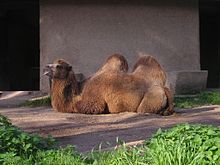Bioparco di Roma
 Camelus bactrianus | |
| Date opened | 5 January 1911[1] |
|---|---|
| Location | |
| Coordinates | 41°55′03″N 12°29′07″E / 41.91750°N 12.48528°ECoordinates: 41°55′03″N 12°29′07″E / 41.91750°N 12.48528°E |
| Land area | 17 ha (42 acres)[2] |
| No. of animals | 1114 |
| No. of species | 222 |
| Annual visitors | 780,057 (2008)[3] |
| Memberships | EAZA,[4] WAZA[5] |
| Website | www |
Bioparco di Roma is a 17-hectare (42-acre) zoological garden located on part of the original Villa Borghese estate in Rome, Italy. There are 1,114 animals of 222 species maintained.
History[]

The zoo was conceived in 1908 to hold exotic animal species for exhibition. Unlike other zoos at the time which mainly worked for scientific criteria, this zoo was designed for the entertainment and amusement of the people. The zoo covered 12 hectares (30 acres) and was erected in the northern part of the Villa Borghese estate; it was opened on 5 January 1911.
Early years[]
The zoo was designed by Carl Hagenbeck, who had already opened a zoo in Hamburg Stellingen. The park was built in the style of that in Hamburg: ditches and pits instead of bars, and generous green spaces.[2]
This initial success did not hold. Attempts were made to stock the zoo with especially rare and exotic animals. Various park expansions were undertaken and in 1926 a further expansion was planned into the neighboring red deer park. In 1933, the architect began his work in the new areas, which were to hold two main attractions: the large aviary and the reptile house which opened in 1935.
After the Second World War[]
The zoo began to deteriorate, although many areas were renovated and others fully rebuilt. In 1970, the reptile house had to be closed due to its ailing condition; its improvements took about nine years and it was finally re-opened in 1983.
From zoo to bioparco[]
The idea to transform the zoo into a biopark was first suggested in 1994. In 1997, a master plan was produced based on the principles of the Gilman Foundation. In April 1998, the organization Bioparco S.p.A. was established to be financed through the city of Rome with 51%, from Costa Edutainment with 39%, and from Cecchi Gori with 10%.
Notable animals[]
Kleinmann's tortoise, which is rapidly nearing extinction in the wild, was successfully bred in 2007. The group in the zoo are animals confiscated from a smuggler's suitcase in 2005.
Gallery[]

Giraffe
Hippopotamus
Brown bears

Pygmy hippopotamus at Fondazione Bioparco di Roma on zooinstitutes.com
Notes[]
- ^ "History". giardinozoologicodiroma.it. Giardino Zoologico di Roma. Retrieved 18 September 2011.
- ^ Jump up to: a b "1911-2011: 100 years of history". bioparco.it. Bioparco Di Roma. Archived from the original on 25 April 2012. Retrieved 11 November 2011.
- ^ "I dossier del Touring Club Italiano: 2009" (PDF). touring.it. Touring Club Italiano. p. 4. Archived from the original (PDF) on 22 September 2012. Retrieved 11 November 2011.
- ^ "EAZA Member Zoos & Aquariums". eaza.net. EAZA. Retrieved 18 September 2011.
- ^ "Zoos and Aquariums of the World". waza.org. WAZA. Retrieved 18 September 2011.
External links[]
 Media related to Bioparco at Wikimedia Commons
Media related to Bioparco at Wikimedia Commons- Official website
- Bioparco di Roma on zooinstitutes.com
- Zoos in Italy
- Tourist attractions in Rome
- Buildings and structures in Rome
- Zoos established in 1911








